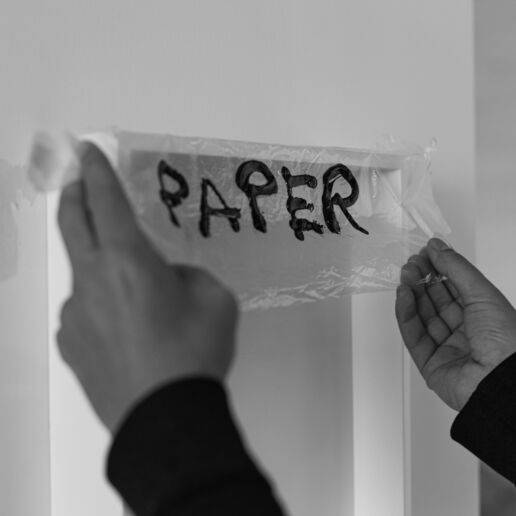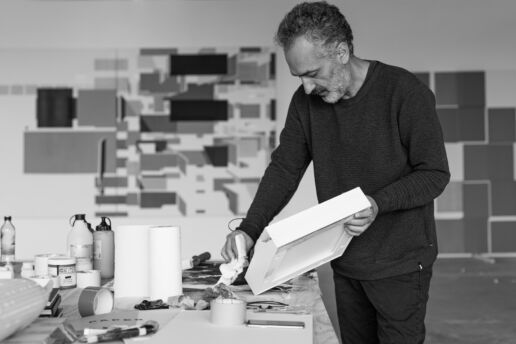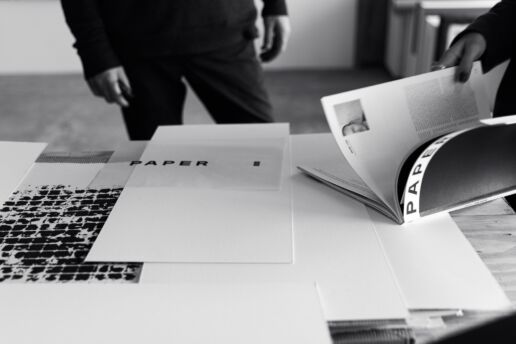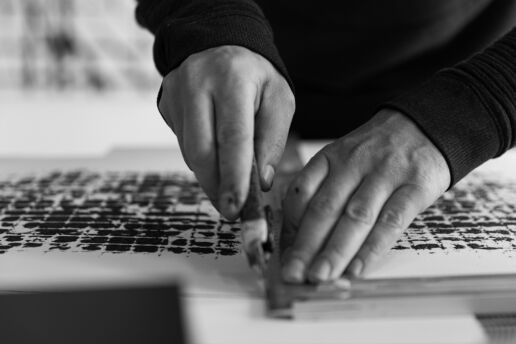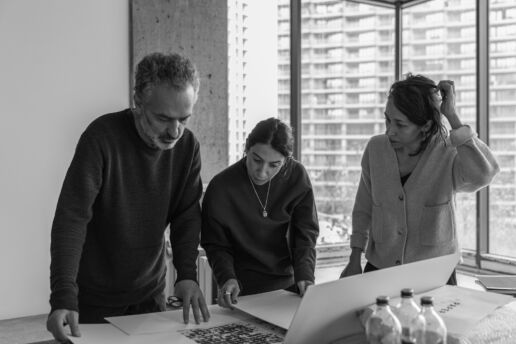PASSAGES
I have been excited since the moment I heard about Nuri Kuzucan’s new exhibition “PASAJ” which will open at ARTER in May. The concept triggers so many images in my head that I feel compelled to first look at the dictionary and then Nuri’s words, blend them all, and create unique passages for this interview.The idea of “passage”, which is essentially a retrospective reflection of Nuri’s mind, comes to life in a different way on the cover of Sanayi313 PAPER’s fourth issue.
PASSAGE
Noun
- A covered narrow way, usually lined with shops on either side and often linking two streets.
I’ve always loved to stroll through passages. I always feel like I will come across a pleasant surprise.
- A usually brief portion/excerpt of a written work or speech.
Finding inspiration in a passage from a story or a novel is like breathing for me.
“Passage” is a word of French origin that has been in use since the 12th century.
Surprise and inspiration are two things that are always inherent in Nuri’s work. I will use this as a stepping stone to move on to Nuri’s “passage“:
“Early on, when ARTER’s head curator and artistic director Emre Baykal and I were discussing the exhibition, he decided to show me the exhibition space. It was very different from your conventional ‘white box’ gallery. In fact, it was a unique experience. The two entrances created a momentum that made it impossible to stop. After taking the stairs down and stepping out the other door, I felt I had command of the entire venue. For me, that transient state created a physical sense of ‘making a passage’. Meanwhile, the interstitial layout of the venue, which is surrounded by other buildings, gave me a feeling of being in-between. The sum of these feelings and experiences manifested in the work I did after visiting the venue. I am a person who deliberates on transitions in my paintings. I want one painting to give birth to another; for form and colour to evoke a texture in the painting. In this sense – one space leading to the next, one aspect of the work leading to others – my paintings and the gallery were a reflection, and a continuation, of each other..”
We also have exhibition curator Nilüfer Şaşmazer standing serenely in the centre of the high-ceilinged section of this passage:
“When the time came to envision the exhibition space, we collaborated with architect Duygu Doğan to bring the design to life. Nuri had a clear idea from the beginning – he wanted to go a step further than merely hanging the paintings on the wall; instead, he wanted them to be positioned in the space and each one to work in tandem with the space itself. There are two factors at play here: The desire to merge the space and the painting and the desire for each viewer to have a personal experience based entirely on their own subjective perception.
You often find architectural elements in Nuri’s work. As a transition zone with two points of entry/exit, I believe that this space will do a good job of hosting this exhibition, which focuses on transition and transience. I am confident that the lighting design that we have planned for the exhibition will complement the geometry, planes and spaces in the paintings. I think that the venue will spotlight Nuri’s works and augment every piece on exhibit. For someone who likes to look at paintings, it is very exciting to see how the perception of a painting can alter depending on the depth of a space, or how one painting works beside, or in proximity to, another painting.”.
TRANSFORMATIONS
Nuri Kuzucan continues:
“Most of the works selected for the ARTER exhibition are new, but it later turned out that everything we planned had some form of visual reference. While discussing the exhibition with Duygu, I came across some paintings that reflected what I had in mind. This allowed me to better explain myself and, more importantly, it allowed us to imagine the kind of atmosphere we wanted to create. In fact, during the design stage, we talked at length about one specific painting, and that painting later became the starting point for the exhibition. The labyrinthine forms in that painting will inform the exhibition area itself or the exhibition area will become a labyrinth-like structure, like the one seen in the painting.”
I was also waiting patiently for the day when Nuri and Sanayi313 would find a way to collaborate. Nuri is both a neighbour and an old friend. We met to discuss the cover of Sanayi313 PAPER’s new issue. We also talked about the affinities we shared. As Nuri says:
“In daily life, we sometimes find ourselves somewhere between feeling vulnerable and feeling engaged, depending on the nature of a particular space. Will we hide in our cocoons or will we become part of our surroundings? Spacious places like Sanayi313 motivate people to get involved. You are much more likely to feel comfortable and be yourself in such places. When I come here, I feel like I have opened a passage to myself.”
COVER
Nuri conceived a fantastic cover for Sanayi313 PAPER. It is between existence and non-existence, between black and white, containing shadows and reflections; a presence/absence where the audience/reader meets the work of art rather than the artist. Nuri explains:
“When we started discussing the cover for the new issue, I had this idea of going a step further. I wanted to come up with solutions within my own domain. There was a period during which I was racking my brain about abstract materials, connotations, and how all this could be transferred to the cover. Eventually, I realised the importance of marking what we wanted to highlight. I would be the one making the point, but it would be in an elusive way. A sense of ease came over me once I was able to position myself outside that design. It seemed like a better idea for the audience to perceive or sense the subject rather than giving them something tangible, immediate and literal.”
COVER #02
The issue of disseminating art across society is actually the main idea behind all the passages in this interview and something we will discuss shortly. Nuri shared one of his works with Sanayi313 PAPER. We sincerely hope that everyone receiving our magazine tears off the cover artwork titled “…..” and hangs it in a place they love. Nuri signed each copy.
A DISCUSSION ABOUT ART FOR SOCIETY’S SAKE
Like all passages, the doors of art should be open to all. But is that really the case?
Nuri and Nilüfer elaborate on the topic:
NK I want art to be easily accessible for the sake of society. In fact, it has become much more widely available in recent years. The perception of art is certainly not linked to an object. There is no hierarchy between a painting obtained with modest means and a painting bought at an auction for extortionate amounts. But of course, there are artists and artistic disciplines that are symbolic and dominant in the art world. Whether we have access to them is a long-running debate that has lingered for centuries. The fact that people make an effort to access art stems from a wish to have a sense of ownership of the art and its ideas. We all have this feeling inside us no matter how hard we try to contain it. Overcoming this urge requires us to completely restructure our relationship with art for the sake of transparency. We need motivation to “transform art into the space we call home”. Art is everywhere, in every phase of our lives.
NŞ Art institutions have a major responsibility here. There are some important steps to be taken. Among those are enabling people to access art events for free or at reasonable prices, organising learning programs and workshops, especially for young people and children as part of organised exhibitions, working in coordination with academic institutions, and developing communication strategies that help the general public understand that art spaces are open to everyone.
NK We must identify and eliminate obstacles. This includes addressing all physical and non-physical barriers. We need to create spaces for art where people will feel comfortable, and where they do not hesitate to reach out and establish contact.
NŞ For example, I believe Istanbul Metropolitan Municipality’s recent initiative is an important step forward. Organising free concerts, exhibitions, and events not only showcases the cultural heritage of the city but also provides new venues capable of hosting these events. Their quality and operations are open to debate, but having them in many places across the city is still very important.
We conclude the interview with Nilüfer’s personal impression of Nuri’s “passages”:
“After long years at the Academy of Fine Arts, studying interior spaces, Nuri shifted his creative focus first to buildings, then to streets, and then to the city as a whole. His horizontal perspective grew into a bird’s-eye view and from there to a much more abstract outlook. Today, I think he has reached a very finely distilled level of production. Nuri has an amazing ability to find this subjective voice. What is more, just like his general attitude to life, his work is not defined by any hierarchy. It is positioned on a plane of equal coexistence. I find it very important that he organised the ‘Open Space’ exhibitions*, his idea of collective/collaborative work, and the relations he established with the works of his contemporaries as well as those of his predecessors. I think that the door to his life and his production process is open to everyone. I hope the cover for the magazine and this interview will introduce him to a wider audience and become an opportunity for people to walk through that door.”
*Nuri Kuzucan curated and organised two exhibitions titled Open Space, respectively in 2020 (Galerist, Istanbul) and 2022 (Imalat-hane, Bursa). In addition to contributing his own work, he also invited other artists to participate in these exhibitions. The aim was to take the works featured in the exhibition as discrete forms and then use them to compose a single pictorial composition.”


